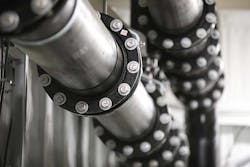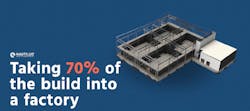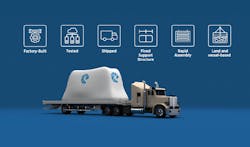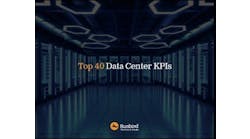We continue our article series on how modular design and sustainability both play a significant role in data center modernization efforts. This week we'll dive into design and modernization strategies related to modular ecosystems.
So far, we’ve covered the concepts of modular infrastructure, how it has changed, the sustainability of such a design, and where these solutions impact modern go-to-market strategies.
Let’s explore four key design strategies to support infrastructure modernization with modular solutions.
1. Speed-to-deployment will be critical to impact your market. It is taking far longer to bring essential infrastructure online than ever before. The main challenge is the supply From the perspective of the supply chain, the impact is surprisingly broad. Everything from materials to construct the physical shell of a data center to the wiring and internal structures has increased in price, and many materials have limited availability. This means that schedules are now more at the mercy of individual suppliers than ever before. When materials aren’t available, there are few options for contractors looking for ways to hit their deadlines.
This means that the projected space availability in data centers is no longer accurate, and customers begin competing for what is available, driving up contract prices. Despite all the issues with new construction, CBRE reports that “the construction pipeline within primary markets increased 153% year-over-year, to 1,839.9 MW.”
These issues also mean that as current contracts end, renegotiating those contracts will be impacted by the increased value of the space, especially as operators look to maximize the value of existing facilities.
If you’re aiming to bring critical infrastructure online, it’ll be vital for you to work with partners that can help you impact your market quickly. Partners like Nautilus Data Technologies are bringing infrastructure online within 12 months. They do this by turning over 70% of the modular data center build into a factory, increasing speed-to-market and reducing net costs.
2. Reducing human error. Uptime Institute’s 2022 Outage Analysis pointed out that over 85% of the incidents stem from staff failing to follow procedures or flaws in the processes themselves. IDC estimates that human error costs organizations more than $62.4 million annually. A significant part of errors created by humans is because of tedious tasks and manual processes. To reduce human error, work with partners that offer configuration flexibility and pre-build as much of the infrastructure as possible.
These facilities are factory-built, tested, shopped, and placed onto a fixed support structure to commission land and vessel-based data centers rapidly. Key components within the design are already pre-built. For example, the electrical and mechanical systems are already in place and ready to be connected. These critical systems do not need to be shipped independently, saving time in deploying and delivering the infrastructure.
3. Consider your physical footprint. As mentioned earlier, we’re not building critical infrastructure like we used to. Data center leaders are aiming to work with modular designs that are highly dense and With prefabricated modular data centers, you can drastically lower your infrastructure footprint. Nautilus aims to create high levels of density and intelligent pre-design to ensure their physical footprint is half the traditional prefabricated modular units.
Remember, as you reduce your footprint and lower the gear you’ll need to deliver your infrastructure, you’ll also reduce the number of components you have to ship. Many will look at 120 or more shipping splits for traditional prefabricated modular designs, and highly efficient designs like those from Nautilus cut those shipments to 39. The reduction in delivery alone can save an organization millions of dollars.
4. Leveraging water and sustainability in the most efficient manner. There is a focus on the data center industry in terms of sustainability and user of power. More recently, we’ve also seen how our critical facilities impact water. While air- cooled infrastructure works well, leaders are looking for even greater density levels to support new types of compute instances. ChatGPT, AI, and machine learning are good examples of this. And so, these operators are turning to water. However, how do you ensure the most responsible usage of a very precious resource? You get innovative.
Water can absorb more heat faster, 3,500 times faster, than an equivalent air or mineral oil mass. Nautilus Data Solutions has created a closed-loop and open-loop water system for cooling I.T. in the most sustainable way possible.
In a closed loop pure water system, water can absorb the heat generated by the I.T. gear via immersion, direct-to-chip, overhead coil, or rear door exchange. The warm water goes back to the heat exchanger to be cooled down and cycled back through the data center.
Open-loop water systems go a bit further. Nautilus’s patented water-cooling technology can intake cool water from any water source, such as greywater or any water body, including lake, river, or ocean. From the large drum intake, the water travels through a multi-step, multi-element filtration process that causes zero harm to wildlife with no chemical additives. The coolness of the water is brought into the heat plate exchanger to cool the water from the closed loop system. When complete, the water is returned to the source with only a minimal increase in temperature.
Here’s why this is so important. These designs leverage zero water consumption, return all used water to the source in an inert state, and use 30% less energy to cool the infrastructure. With this in mind, data center tenants don’t have to choose air or liquid cooling; they can certainly do both. Options include air-cooling operating with contained hot aisles, direct-to-chip, rear-door heat exchange, or immersion. In a single facility, cooling can scale from 10kw per rack to 100kw per rack.
Download the entire report, Modernizing Efficiency and Time-to-Market: A New Approach to Data Center Design, featuring Nautilus Data Technologies, to learn more. In our next article, we'll look at how these modular solutions operate in the real world.








